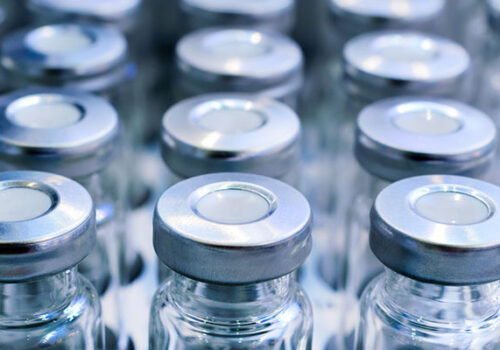Providing patients with lifesaving medicines in remote parts of the world can be a challenging undertaking for the transportation and packaging sector, such as temperature sensitivity, humidity, shaky roads and the global threat of falsified drugs.
One major logistical challenge for the pharmaceutical industry is providing GDP-compliant carriage of partial loads or small, urgent shipments to difficult to reach areas outside of the EU. Providing aid and medicines to developing countries and other parts of the world, with often a less developed infrastructure and tropical climates, is far from an easy task. Vaccines for example are highly sensitive to temperature changes and basically have to be kept cold all the way until they reach the recipient’s arm or mouth. Each year vital vaccines remain undelivered to more than 20 million children globally, as the vaccine hasn’t withstood the transport.
Transportation matters
Transporting pharmaceuticals in more remote parts of the world thus demands carefully thought-out strategies. Temperature and security are some of the key factors to consider, says Thomas Schleife, CEO of TRANSCO Berlin Brandenburg GmbH, a logistics services provider. The German freight forwarder and transportation company focuses on truck transport services to connections in Eurasia, mainly the CIS countries, Turkey, Iran and Mongolia.
“Inside of Europe, transport is mainly over shorter distances. But start going outside of the continent and entering more ‘exotic’ countries, such as in Asia for example, and this provides a whole other challenge. Firstly you have to take into consideration the change of distance, as you are making transports over a 7 000 km long route instead of 2 000 km. This also involves reviewing what kind of infrastructure is available in the region. Roads might not be functioning well everywhere, for example, which is an issue that we generally don’t face in Europe. Iran and Mongolia are for instance emerging markets that are also challenging, with a need for more modernized infrastructure. You also need to have custom regulations in mind, which poses a difficulty for temperature sensitive carriage. Another issue is of course dealing with different types of climates in these regions, where it can be + 40 °C in the summer and – 40 °C in the winter. An important part is thus to learn what it really means to enter this type of market, thoroughly revising the strategy to guarantee security and temperature control over the whole process.”
Temperature control of the trucks that Transco run is managed with telematic solutions that define set points and temperature regimes as well as a special blocking system on high-security transports. Some of Transco’s haulage vehicles are equipped with a special GPS-remote-door-locking-system. The doors can only be opened via GPS and a monitoring device allows for constant door status, for example if there is an attempt to open the truck. Transco has chosen to outsource this process to a professional monitoring partner.
“In case of any deviations we are contacted instantly and they help us with any problems that can arise,” says Thomas Schleife.
The importance of packaging
The right packaging that protects the medicine is an equally significant matter. Safe packaging for more difficult to reach destinations is becoming an increasingly important issue, says Glenn Svedberg, Managing Director at Nolato Medical Pharma Packaging. The company is specialized in the development and manufacture of primary plastic packaging for the pharmaceutical and VMS (Vitamins, Minerals and Supplements) industries.
“We are seeing more customers selling products on a global market, with clients making more careful decisions in their strategies. We’ve had customers that have changed from one packaging system to a more expensive solution because they felt the pressure from the market. Packaging solutions that were acceptable ten years ago might not be so today.”
Protecting against moisture
A current issue for Nolato Medical’s customers has revolved around the tightness of the packaging to protect the content from moisture. The expansion onto global markets includes tropical zones with warm and humid climates. Depending on the type of product, Nolato Medical works with different strategies to ensure that the medicine is protected from moisture, says Glenn Svedberg.
“The old pills were based on chemicals and the biggest source for degradation was water and moisture. With these types of drugs there is for example the possibility of adding capsules that absorb the moisture if the medicines are very sensitive or the market is a tropical zone with high humidity. New types of medication that are often bio-based have a very complex molecule chain and are oxygen sensitive, since it is a living bacteria. Just like food it oxidates. These types of pharmaceuticals are a bit more challenging when it comes to safe packaging. When it comes to liquid drugs we work with different barriers to decrease the oxygen permeation. However, the most crucial part is getting around the problem of leakage between the cap and the container. If you have a container with barriers, the integrity between cap and container is the most important.”
Another possibility is adding other materials that are completely oxygen-proof such as EVOH layers, says Glenn Svedberg. At Nolato Medical stability studies are also made where the pharmaceuticals are put into a climate container with a certain cycle. The container is designed depending on the temperature and humidity that is considered for the transportation.
New indicator designed to save lives
Securing an approved temperature and accordingly a working vaccine for difficult to reach crisis areas is also being helped by a new Swedish innovation. Research institute Acreo Swedish ICT has in collaboration with the international humanitarian-aid organization Doctors Without Borders developed a temperature indicator for the transportation of pharmaceutical products. The indicator is designed as a tag that is attached to the package and provides a solution that is also more cost-effective.
The temperature sensor consists of printed components and a silicon chip, forming an integrated measuring system for temperature monitoring. The sensor system can detect if a parcel with sensitive medicines like a vaccine has been exposed to temperatures outside of a predefined interval. The result is presented on the display. The temperature tag can also be attached to the package after repackaging, which enables a more flexible surveillance as it can be adapted depending on the scenario. The printed indicators could be placed on a “secondary package”, that is, the cardboard package closest to the vaccine ampoule. It could gather more information about the conditions during the freight but also transfer that information closer to the end-user to maintain the historical data in the transportation chain. The sensor would also be able to indicate if products have been exposed to low temperatures below freezing.
According to Marpe Tanaka at Doctors Without Borders, the printed sensor provides a promising possibility for maintaining the correct temperatures for important pharmaceuticals and would offer a better tool for the end user to assess if the product measures up.
“The longer out in the field you get, the harder it is to maintain the right temperature in the logistic chain, which is extremely important to ensure the quality of the vaccine or medicines and ultimately the healthcare that we give to our patients. Alternative solutions to the current means of transportation are often very expensive,” Tanaka stated in a press release.
Falsified medicines – a growing concern
Besides dealing with temperature, humidity and shaky small roads in countries with a less developed infrastructure, the perhaps biggest concern throughout the whole supply chain is the global issue of counterfeit drugs. Falsely produced, packaged and labelled medicines are a growing worldwide trend that for a long time has posed a problem for the industry, but more importantly a lethal threat to patients in need, in the most vulnerable parts of the world. Counterfeit versions can lack vital active ingredients, rendering the drug more or less useless, or even worse they can contain active ingredients that can become a health risk for patients. Developing countries have been the prime targets for falsified medicines. Asia currently represents the largest market but Latin America and Africa are also attractive targets. Around 30% of the drugs distributed in these regions are estimated to be counterfeit, reports World Courier.
“Counterfeit medicines are a huge problem and this is a prioritized issue for us. Subsidized drugs like HIV and AIDS medicines are especially attractive targets that mean a lucrative deal. Also, with the increase of online purchases of medicines, this problem has escalated even more,” notes Glenn Svedberg.
Various initiatives, collaborations and actions are initiated to tackle this ongoing issue. Regulatory reforms are underway, such as a joint EU labelling system. From 2019 each individual package of prescription drugs has to be labelled with safety details, such as a unique serial number and a secure seal. Pharmaceutical packaging has over time been able to provide better protection for product and patient. From the industry side, new types of products and solutions have also started to emerge.
“Current solutions are based on various types of sealing, for example. Some manufacturers have chosen to include a smaller detail on the product so that only someone with enough knowledge can identify the right package. Another option is working with 3D bar codes where much information can be hidden, or other digital solutions such as invisible markings,” says Glenn Svedberg.
He gives an example of a type of fingerprint that one of their collaboration partners has developed. The solution, from Swiss AlpVision, consists of microscopic surface irregularities that are incorporated into a mold. The company then uses these unique characteristics as the means of authentication. The process requires capturing a digital image of the matte-finished surface of a molded part and storing it in a database. This image is then used as a reference to perform product authentication which can be done with a standard office scanner or a regular smartphone equipped with a product authentication application.
Thomas Schleife points out a thorough risk analysis and having the right staff as two approaches to tackle the counterfeit issue for the transportation industry.
“Make sure you are hiring people with experience and who know their job, especially coming from the specific country. They know the situation and conditions and give you an advantage knowledge-wise but also language-wise. It is also vital to have clear planning processes where you do a comprehensive risk analysis for long distances, listing potential problems. You can never know in detail what sort of difficulties will emerge along the way but it is very helpful to have some basic points that are integrated into the plan. Sort out some action processes that are well documented.”
Mätning av vaccintemperatur Photo Acreo Swedish ICT









